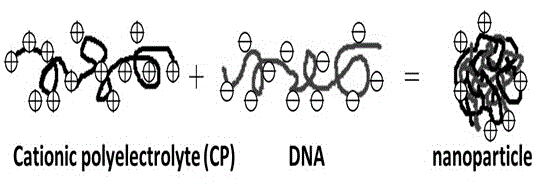Surface-mediated gene therapy type artificial lens and preparation method for same
An intraocular lens and gene therapy technology, applied in intraocular lenses, eye implants, etc., can solve problems such as damage, reduce incidence, avoid toxic side effects, inhibit epithelial cell proliferation or induce lens epithelial cell apoptosis. Effect
- Summary
- Abstract
- Description
- Claims
- Application Information
AI Technical Summary
Problems solved by technology
Method used
Image
Examples
Embodiment 1
[0027] First, take a clean intraocular lens and surface-treat it with an amino functional group-containing surfactant to bring amine groups on its surface: choose polymethyl methacrylate rigid intraocular lens, immerse into 3mg / mL polyethylene In the imine solution, act for 6 hours, a layer of polyethyleneimine is adsorbed on the surface of the intraocular lens material, washed with water, and dried with nitrogen gas for later use. Then immerse the intraocular lens activated by amine groups on the surface into a 100 μg / mL plasmid DNA solution containing the gene encoding p53 protein, and adsorb a layer of plasmid DNA on the surface of the intraocular lens material through electrostatic adsorption, as shown figure 1 shown.
Embodiment 2
[0029] The cationic polyelectrolyte solution and the plasmid DNA solution containing functional gene fragments are mixed together to prepare electrostatic association nano-gene carriers. The preparation principle is as follows: figure 2 shown. In this embodiment, cationic polyelectrolyte chitosan and plasmid DNA containing a functional gene fragment encoding p53 protein are used as examples. Dissolve 50mg of chitosan (hereinafter abbreviated as CHI) in 50mL of acetic acid buffer solution (pH=5.5). The plasmid DNA (hereinafter abbreviated as pDNA) solution of the fluorescent protein gene was mixed with 10 mL of the above CHI solution, vortexed and oscillated for 30 seconds at room temperature, and the non-viral vector CHI- pDNA nano-associate solution, the preparation process is as follows image 3 shown.
Embodiment 3
[0031]First, take a clean intraocular lens and surface-treat it with an amino functional group-containing surfactant to bring amine groups on its surface: select polymethyl methacrylate rigid intraocular lens, immerse it into 3mg / mL polyethylene In the amine solution, act for 6 hours, a polyethyleneimine layer is adsorbed on the surface of the intraocular lens material, washed with water, and dried with nitrogen gas for later use. Then immerse the intraocular lens activated by amine groups on the surface into 1 mg / mL anionic polyelectrolyte heparin (hereafter abbreviated as HEP) solution, and electrostatically adsorb for 30 minutes, and a layer of negatively charged heparin is adsorbed on the surface of the intraocular lens material; then Immerse the intraocular lens into the non-viral carrier CHI-pDNA nano-association solution containing functional genes prepared in Example 1 for 30 minutes, and a layer of positively charged CHI-pDNA nano-associations is adsorbed on the surfac...
PUM
 Login to View More
Login to View More Abstract
Description
Claims
Application Information
 Login to View More
Login to View More - R&D
- Intellectual Property
- Life Sciences
- Materials
- Tech Scout
- Unparalleled Data Quality
- Higher Quality Content
- 60% Fewer Hallucinations
Browse by: Latest US Patents, China's latest patents, Technical Efficacy Thesaurus, Application Domain, Technology Topic, Popular Technical Reports.
© 2025 PatSnap. All rights reserved.Legal|Privacy policy|Modern Slavery Act Transparency Statement|Sitemap|About US| Contact US: help@patsnap.com



